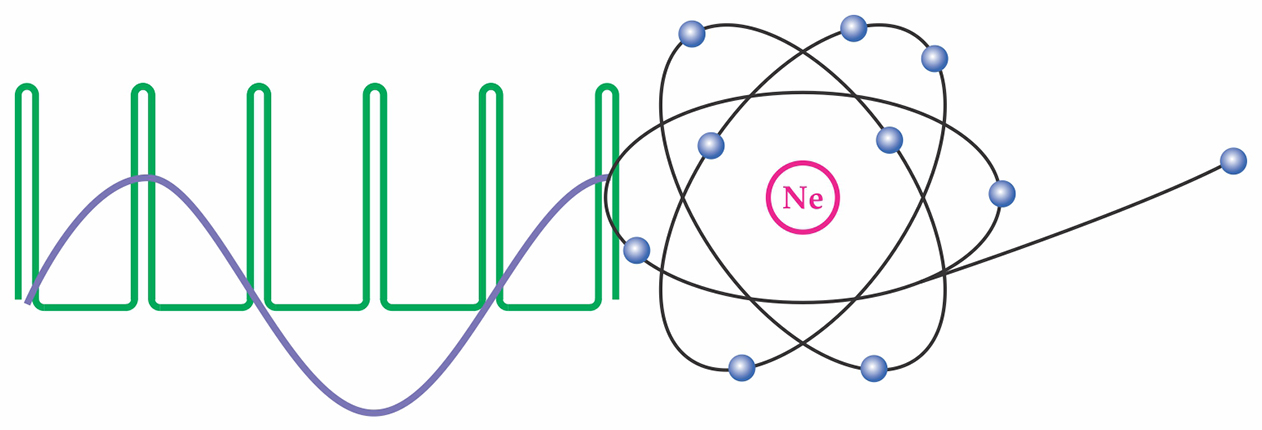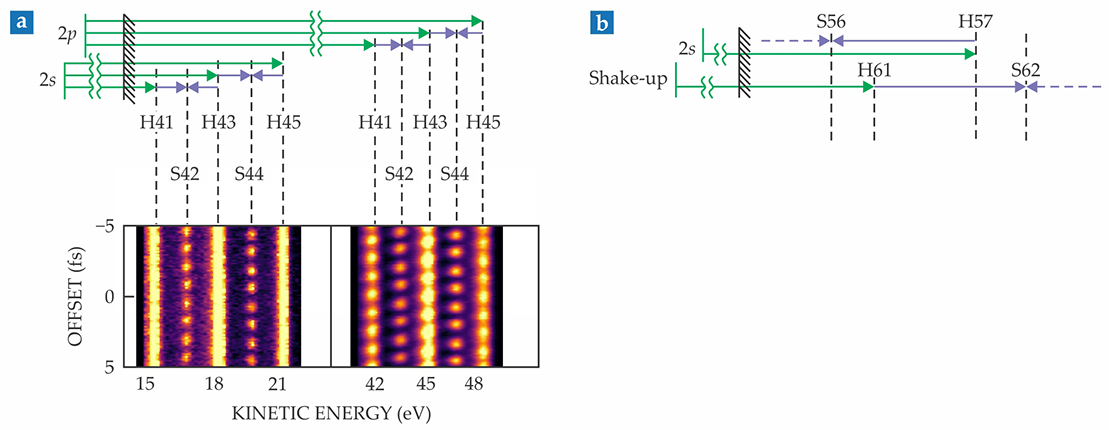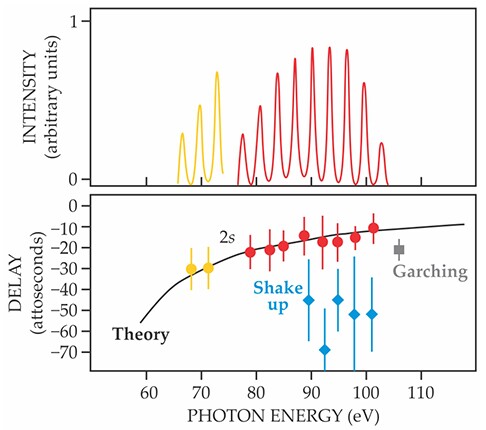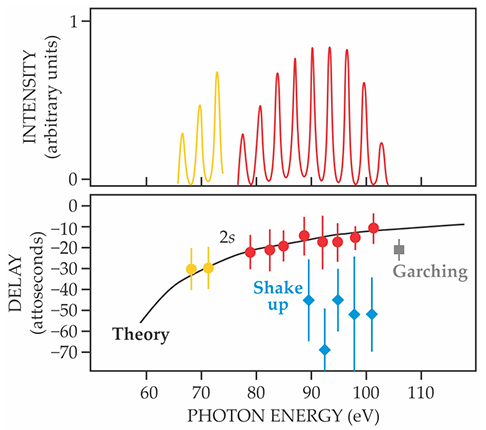Attosecond measurements reach electronvolt precision
DOI: 10.1063/PT.3.3809
If you know where you are, you don’t know where you’re going, and if you know where you’re going, you don’t know where you are: The Heisenberg uncertainty principle fundamentally limits how precisely position and momentum can simultaneously be known. Another formulation of the principle, linking the uncertainties of energy and time, would seem to suggest that ultrafast measurements—such as the attosecond experiments that probe electronic motion in atoms, molecules, and solids—can’t be both temporally and spectrally precise.
But that’s not quite true. The uncertainty principle does place a lower bound on the product of the time and energy uncertainties of an isolated electromagnetic pulse. An experiment’s temporal precision, however, is not limited by the duration of the pulses used in it; rather, it’s often determined by the degree of control over the relative timing of two pulses. Extreme UV (XUV) pulses with durations on the order of 100 attoseconds can nevertheless make measurements with few-attosecond precision.
Spectral precision is another matter. The spectral bandwidth of single attosecond XUV pulses is typically around 10–20 eV. Processes—such as atomic ionization channels—whose energies differ by less than that seem irretrievably blurred together.
Now Marcus Isinger at Lund University in Sweden, his thesis adviser Anne L’Huillier, and their colleagues have performed an attosecond experiment
1
that resolves two ionization processes in neon separated by just 7.4 eV. Instead of isolated attosecond pulses, they used a train of pulses (depicted in green in figure
Figure 1.

Photoionization of neon probed by a train of attosecond pulses (green) combined with an IR wave (purple). The ionization signal exhibits constructive or destructive interference, depending on the photoionization time delay and the timing offset of the two waves.

The technique, called RABBIT (for “reconstruction of attosecond beating by interference of two-photon transitions”), has been around since 2001. 2 But by using it to disentangle processes so close in energy, the Lund researchers have solved a puzzle that’s plagued the attosecond community for seven years.
Photoionization delay
In a landmark 2010 experiment, researchers at the Max Planck Institute of Quantum Optics in Garching, Germany, showed that when an atom absorbs light and ejects an electron, the absorption and emission don’t happen at the same instant. 3 Their technique, called attosecond streaking, combines an XUV pulse some 200 attoseconds in duration with a longer IR pulse. The XUV radiation ionizes the atoms, and the IR field, depending on its phase at the moment of ionization, either accelerates or decelerates the liberated electrons. A streaking spectrogram, which records the electron kinetic energy as a function of the timing offset between the XUV and IR pulses, displays clear oscillations whose phase depends on the delay between XUV absorption and electron emission.
Because there’s no way to tell where zero is on the offset axis, a single streaking spectrogram says nothing about the absolute photoionization delay. Simultaneously captured spectrograms of two photoionization processes, however, can reveal the difference between their time delays. The Garching researchers used an XUV energy centered at 106 eV, enough to pluck an electron from either the 2s or 2p subshell of the Ne atoms they studied. The binding energy of a 2s electron exceeds that of a 2p electron by 27 eV, so the spectrograms differ in energy by the same amount—comfortably in excess of the 14 eV bandwidth of the XUV pulse.
Comparing the two spectrograms showed that 2p ionization lags behind 2s ionization by 21 ± 5 attoseconds. That result had an important implication for the emerging field of attosecond science: The time at which a photoelectron is released could no longer be considered a reliable measure of when an attosecond pulse strikes its target.
But there was a problem. Of the 21 attosecond difference in delay times, theory could account for at most 9 attoseconds. Computational studies of Ne photoionization are unavoidably inexact: The time-dependent Schrödinger equation doesn’t admit exact solutions for atoms with more than 2 electrons, and Ne has 10. But approximations are extremely sophisticated, and as theorists have refined their calculations over the years, their results have converged on a delay that’s much shorter than the Garching measurement. If the discrepancy stemmed from some undiscovered systematic error—theoretical or experimental—it could cast broad doubt on attosecond results.
Shake-up
One reason multiparticle quantum computation is so hard is because the particles are correlated: A 10-electron wavefunction, for example, can’t be decomposed into the products of 10 one-electron wavefunctions. In computational chemistry, it’s usually necessary to account for electron correlations to get results that are even qualitatively correct. And in atomic systems, correlations engender processes in which two or more electrons move simultaneously in response to a single stimulus. For example, in Ne, a single photon might remove an electron from a 2p orbital and promote a second 2p electron to the 3p subshell. That so-called shake-up process requires just 7.4 eV more energy than direct ionization from the 2s subshell. It would have gone unresolved in the Garching experiment.
“We thought about shake-up seven years ago,” says Vladislav Yakovlev, who coordinated the theoretical support of the experiment, “but we didn’t have means to properly simulate it in neon, and we didn’t believe it would be the major cause of the discrepancy.” If shake-up played an important role, the reasoning went, the measured delay would be sensitive to the XUV pulse bandwidth. But there was no significant difference between delays measured with shorter, broadband pulses and those measured with longer, narrower-band ones.
By 2014 Johannes Feist of the Autonomous University of Madrid and collaborators had developed their calculations to the point that they could simulate shake-up’s effect on the Ne streaking spectra. 4 They found that shake-up was in fact prevalent enough to affect the measured delay. More recently, Garching’s Martin Schultze and colleagues used attosecond streaking to study shake-up timing in helium. They found that direct ionization lagged shake-up by between 5 and 12 attoseconds, depending on the ionization energy. 5 Shake-up in He is separated in energy from direct ionization by more than 40 eV, so it can be resolved in a streaking experiment. Measuring shake-up in Ne would require a different method.
Spectral resolution
The essence of the Lund RABBIT experiment is shown in figure
Figure 2.

Separating ionization processes. (a) When neon is ionized by a combination of extreme UV (green) and IR (purple) photons, electrons from the 2s and 2p subshells are easily distinguished by their kinetic energy. The relative photoionization delay at each two-photon sideband energy (S42 and S44 shown here) can be inferred from the phase difference of the oscillating ionization signals. (b) Shake-up and 2s electrons overlap in energy. But their sideband signals (S56 and S62 here) can still be resolved. (Adapted from ref.

Those processes can interfere either constructively or destructively, depending on the timing offset of the XUV and IR waves. Adjusting the timing, therefore, creates oscillations in the sideband signals’ intensity (not their kinetic energy, as in streaking), as evidenced by the trains of spots at the energies of sidebands S42 and S44 in the figure. The phase of the oscillation depends on the photoionization delay. At the S42 energy, then, the relative delay of 2s and 2p direct ionization corresponds to the vertical displacement between the spot trains at 16.5 eV and 43.5 eV. The delay, which amounts to tens of attoseconds, is too small to be perceptible by eye in the figure, but it can be extracted from a sinusoidal fitting of the data.
Figure
The results are summarized in figure
Figure 3.

Photoionization time delays, all shown relative to 2p direct ionization. With the photon spectra shown in the top panel, relative delays can be measured at the sidebands between each pair of neighboring harmonics. The negative delay values mean that 2p direct ionization lags both 2s ionization (yellow and red) and shake up (blue). The results of the Garching experiment

Although the Lund experiment doesn’t quite reach the same photon energy the Garching researchers used, the results strongly implicate shake-up as the cause of the earlier discrepancy: The new 2s ionization measurements agree well with calculations, and the Garching measurement is in between the 2s and shake-up delays. With confidence thus restored to their methodology, attosecond researchers are ready to push their understanding to new frontiers. “Neon photoionization in this energy range seems quite understood now,” says L’Huillier. “But there are many interesting questions in other energy regions and other systems. This is just the beginning.”
References
1. M. Isinger et al., Science 358, 893 (2017). https://doi.org/10.1126/science.aao7043
2. P. M. Paul et al., Science 292, 1689 (2001). https://doi.org/10.1126/science.1059413
3. M. Schultze et al., Science 328, 1658 (2010). https://doi.org/10.1126/science.1189401
4. J. Feist et al., Phys. Rev. A. 89, 033417 (2014). https://doi.org/10.1103/PhysRevA.89.033417
5. M. Ossiander et al., Nat. Phys. 13, 280 (2016). https://doi.org/10.1038/nphys3941
